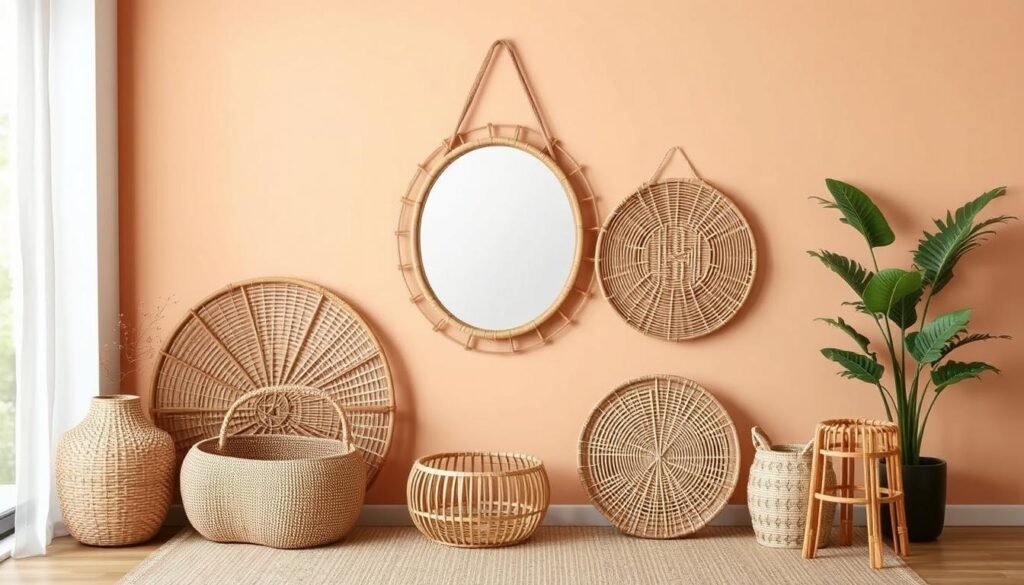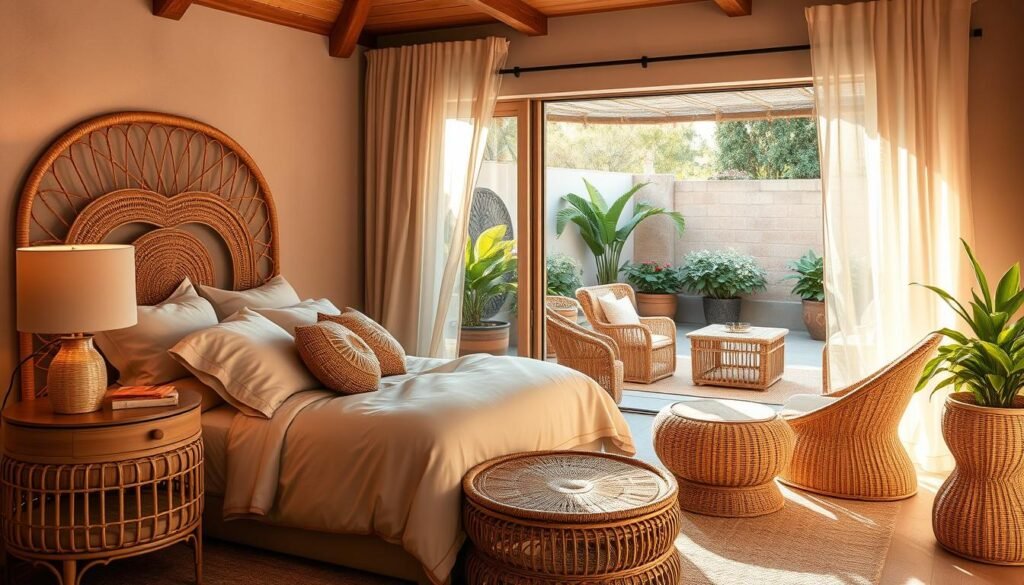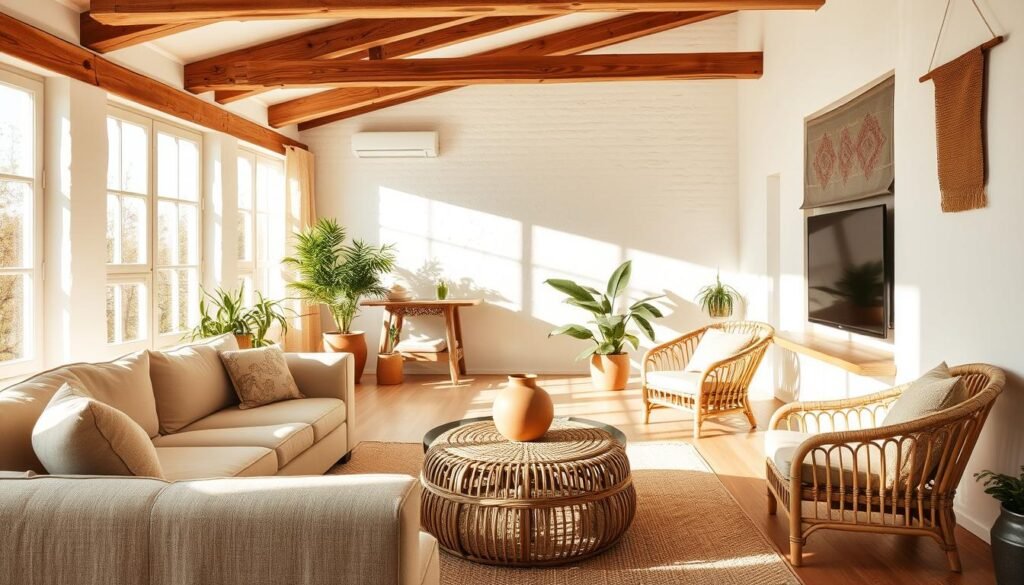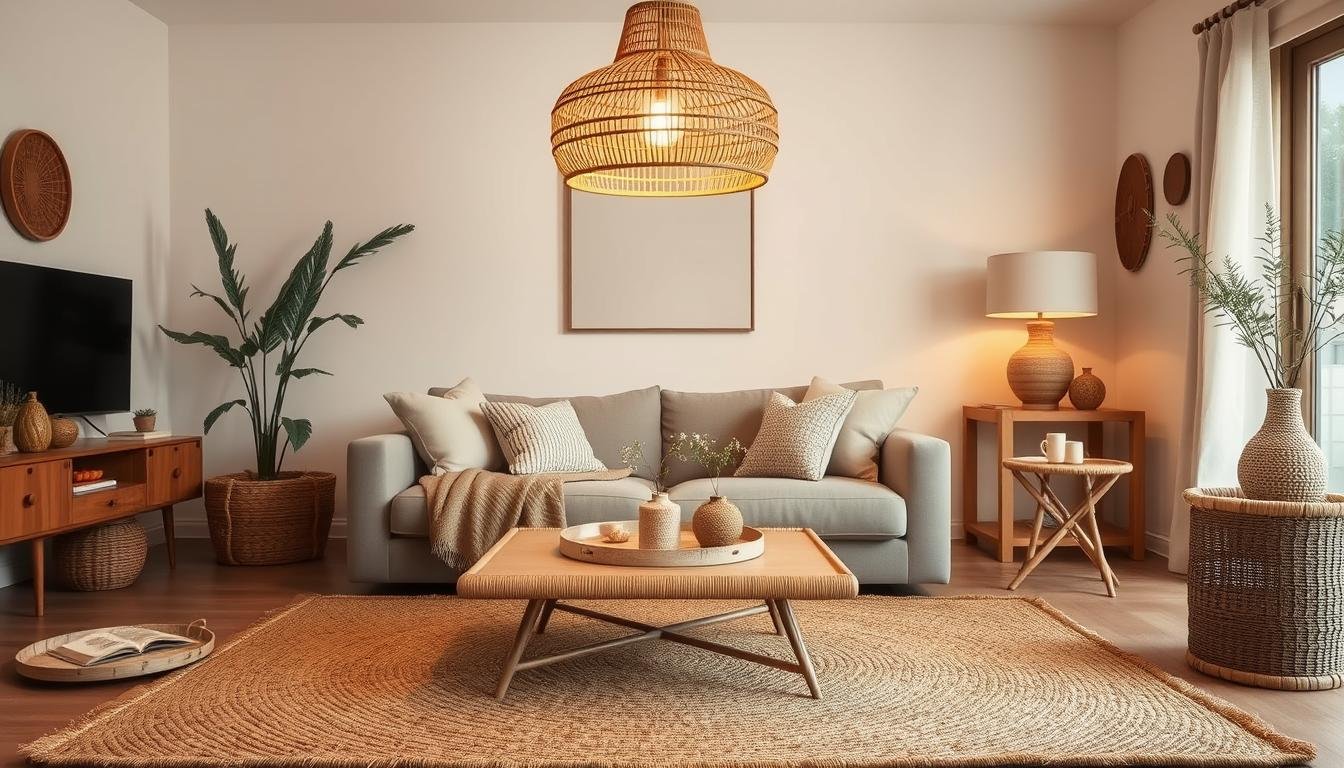This post may contain affiliate links. When you purchase through links on our site, we may earn an affiliate commission.
What if the secret to a truly inviting home isn’t found in stores, but grows in nature? I asked myself this years ago while staring at my overly polished living room. That’s when I discovered how organic fibers could breathe life into spaces—without sacrificing modern appeal.
My love for earthy materials started with a single rattan chair. I learned this palm fiber bends without breaking, just like great design adapts to life’s changes. Unlike plastic or metal, it ages gracefully, developing character with every sunbeam that touches its surface.
Now, my rooms feel like extensions of the outdoors. Woven baskets hold blankets, textured wall art catches shadows, and furniture seems to grow from the floors. The best part? Every piece tells a story of sustainability—these renewable resources come straight from tropical forests to my front door.
I’ve found that blending these elements creates harmony. Too much sleek metal feels cold; too many raw fibers seem unfinished. But together? They sing. My home isn’t just styled—it’s alive, evolving as I discover new ways to honor nature’s artistry.
Key Takeaways
- Organic materials add depth and character that synthetic options can’t replicate
- Renewable fibers like rattan offer durability while reducing environmental impact
- Mixing textures creates visual interest without overwhelming a space
- Woven elements introduce warmth that makes rooms feel instantly welcoming
- Authentic design starts with pieces that reflect your connection to nature
Embracing the Natural Beauty of Rattan and Jute
Three years ago, I swapped my mass-produced coffee table for a rattan piece that changed everything. That decision taught me how organic elements transform houses into living ecosystems. Spaces breathe differently when they contain materials that once grew in soil.
https://www.youtube.com/watch?v=8OlXchoKKZg
Why Nature’s Offerings Matter
Factory-made items often feel sterile compared to pieces shaped by rainfall and sunlight. My rattan shelf darkens where afternoon light hits it, creating patterns no machine could replicate. These imperfections become conversation starters rather than flaws.
| Material | Age Gracefully? | Eco-Friendly? | Color Evolution |
|---|---|---|---|
| Rattan | Yes | Renewable | Warm patina |
| Plastic | Cracks | No | Fades |
| Steel | Rusts | High energy use | Dulls |
From Doubt to Devotion
I initially worried about durability until my first woven basket outlasted three plastic counterparts. Now, every room contains elements that connect to outdoor landscapes. A jute rug here, a palm-leaf bowl there – these choices make my apartment feel rooted in something real.
What surprised me most? How these pieces adapt. The same neutral tones work with bold accent walls or muted palettes. They don’t fight for attention but anchor the space. My home’s become a testament to materials that live, breathe, and tell stories.
How to Showcase Natural Textures Such as Rattan and Jute in My Home
I once overcrowded my living area with woven pieces, creating a cluttered jungle instead of a sanctuary. That’s when a designer friend shared the 90/10 rule – using palm fiber elements as 10% of a room’s composition. This balance prevents spaces from feeling like craft stores while letting organic charm shine.

Key Elements to Consider
Scale determines everything. My oversized rattan headboard anchors the bedroom without dominating, while petite side tables add subtle character to tight corners. I pair these with linen curtains and wood frames, creating layers that whisper rather than shout.
Lighting transforms materials dramatically. Morning sun highlights intricate weaves in my breakfast nook, while evening lamps cast cozy shadows on woven wall hangings. I test placements by observing how pieces interact with light at different hours.
Color palettes guide my choices. Neutral rooms handle bold rattan statements, while vibrant walls get simpler designs. For patterns, I stick to solid tones or faint geometric prints that let the material’s inherent texture become the star.
Every piece must earn its keep. Storage baskets hold blankets, planters double as art, and chairs prioritize comfort over trends. This approach keeps my home functional while celebrating materials that connect me to nature’s rhythm.
Transforming Living Spaces with Rattan Accents
I discovered rattan’s magic when my living room felt stale despite expensive upgrades. This flexible material became my secret weapon for creating warmth without renovation chaos. Its airy structure and neutral tones let me experiment freely while maintaining cohesion.
Refreshing With Flexible Furnishings
My rattan chairs became shape-shifters in open-plan areas. I cluster them around coffee tables for game nights, then spread them near windows for reading nooks. Their featherlight build makes rearranging feel like redecorating – zero heavy lifting required.
| Material | Visual Impact | Maintenance | Cost |
|---|---|---|---|
| Rattan | Warm texture | Dust weekly | $$ |
| Linen | Soft contrast | Machine wash | $ |
| Wood | Earth tones | Polish monthly | $$$ |
Blending Materials Strategically
I balance woven pieces with plush fabrics and smooth surfaces. A rattan console gets topped with marble lamps, while side tables host knitted coasters. This mix prevents monotony and lets each material shine.
Accent tables became my favorite discovery. They hold plants and books while adding subtle pattern play. Paired with velvet ottomans, they create inviting spots that guests naturally gravitate toward.
Elevating Bedrooms and Outdoor Areas with Natural Materials
My bedroom transformation began when I swapped a bulky armchair for a curved rattan seat. This simple change revealed how organic elements could soften hard edges in personal spaces. The material’s warmth now flows from sleeping areas to exterior zones, creating harmony between indoor retreats and alfresco living.

Integrating Rattan for Cozy Bedrooms
That sculptural chair became my favorite reading spot. Its open weave pattern catches afternoon light, casting delicate shadows that dance across walls. I later added a bench at the bed’s foot – perfect for laying out clothes or perching while tying shoes.
These pieces work magic after dark too. Soft lamp glow highlights their intricate details, creating a tranquil vibe that helps me unwind. I’ve found rattan furniture strikes the right balance between visual interest and calming neutrality.
Enhancing Balconies and Patios with Durable Designs
Outdoor spaces demanded a tougher approach. I chose weather-resistant rattan stools that survive sudden rain showers when dried properly. Their earthy tones blend with concrete planters and iron side tables, forming inviting clusters for morning coffee.
| Location | Best Use | Care Tips | Style Tip |
|---|---|---|---|
| Bedrooms | Accent chairs | Dust monthly | Pair with linen textiles |
| Patios | Stackable stools | Dry after rain | Mix with metal accents |
I protect outdoor pieces with quick-dry cushions and occasional oil treatments. This maintenance keeps them looking fresh through seasons while maintaining that cherished connection to nature’s rhythms.
Designing Japandi-Inspired Interiors with Organic Touches
The first time I paired a rattan pendant light with my Scandinavian sofa, I realized materials could whisper. Japandi style thrives on this quiet dialogue – where Japanese craftsmanship meets Nordic restraint. My spaces now breathe through careful contrasts of smooth and woven surfaces.

Subtle Weaves Meet Clean Lines
In my dining area, four rattan chairs surround a concrete table. Their curved backs soften the industrial base while maintaining the room’s airy feel. This combination creates visual warmth without cluttering sightlines – essential in minimalist interiors.
I’ve found light fixtures make perfect partners for this style. A single woven pendant above my breakfast nook casts intricate shadows that change with the sun. These dynamic patterns add movement to otherwise static spaces.
My approach uses rattan as punctuation rather than prose. A storage basket under the console table. A stool beside the reading lamp. These small touches introduce organic rhythm to monochromatic rooms. They work across different styles too – from zen-inspired meditation corners to modern kitchenettes.
The magic lies in restraint. Too much weave feels busy; too little loses connection to nature. My rule? Add one rattan element per functional zone. This maintains the calm, meditative quality central to Japandi design while letting materials tell their gentle story.
Conclusion
My home’s transformation began with a single rattan stool. That humble piece revealed how organic materials could redefine entire spaces through quiet elegance. Now, every room tells its own story through woven accents that serve both form and function.
I’ve found palm fiber works equally well as statement furniture and subtle decor. Dining stools gain personality with cane backs, while storage baskets add warmth to bare corners. These pieces anchor rooms without dominating them, creating focal points that feel intentional yet effortless.
What surprises me most is rattan’s color adaptability. Its earthy tones blend with bold walls or monochrome palettes, proving versatile across design styles. Light fixtures cast intricate shadows on textured surfaces, while accent tables host everything from coffee mugs to thriving plants.
Friends often remark how my interiors feel lived-in yet polished – a balance achieved through material contrasts. Plush linens soften woven chairs, while marble surfaces complement rough-hewn baskets. This interplay creates depth that synthetic materials can’t replicate.
Through trial and error, I’ve learned that great design honors nature’s imperfections. My home now breathes with organic rhythm, welcoming guests through spaces that feel curated yet completely authentic. The right materials don’t just fill rooms – they shape experiences.

 using WordPress and
using WordPress and 
No responses yet